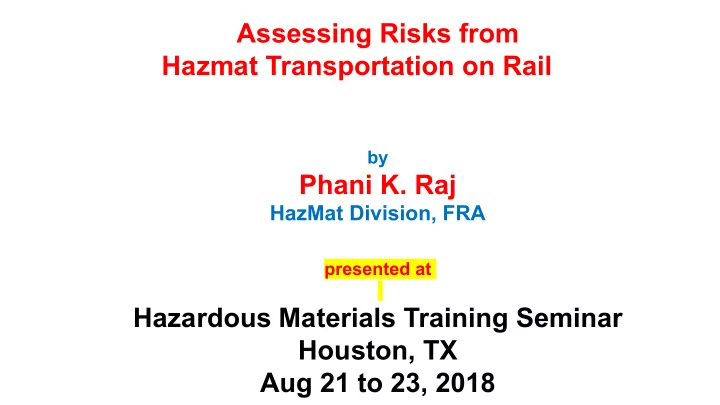

Assessing Risks from Hazmat Transportation on Rail by Phani K. Raj HazMat Division, FRA presented at Hazardous Materials Training Seminar Houston, TX Aug 21 to 23, 2018
DISCLAIMER • All references to companies, their names, addresses and other attributes indicated in this presentation are for example purposes ONLY and should NOT be construed as facilities in any FRA action plan. • Any data used for illustrating the details of Risk Assessment or results shown are to be considered as fictitious and are NOT attributed to any specific institution.
What is in this presentation? General discussion on what constitutes “Risk.” Usefulness of risk assessment; why should an FRA inspector care? Voluntary and Involuntary Risks Individual Risk and Societal Risk. Elements to be considered in risk evaluations Description of an approach Example results and how to interpret the results.
Common experiences of Risk Our own activities such as (i) driving at high speed on a highway, (ii) going to a beach and swimming in the sea, (iii) flying, etc. “Risk” by dictionary definition is “A situation involving exposure to danger.” “Risk” for technical evaluations is “Occurrence likelihood of a defined hazard when a person is exposed to adverse conditions.” Risk is not just a magnitude of a harm but also how likely such a harm can come to a person, over a period. An exposure may result in many types of harms, both immediate and long term. The totality of harms and their likelihoods constitute the total risk.
Why should we (FRA) care about risk or its assessment? FRA mission is to ensure and improve safety to public and RR workers (without adversely impacting nation’s economic activity). This can be done only when we have a bench mark for current levels of safety. A Risk analysis considers all types of hazards, how they originate and circumstances that impact safety. Alternative routes of hazmat shipments (if exists) can be analyzed and the one that poses least risk can be chosen. Risk or performance based, data driven, regulations are becoming the new norm; we need to be able to understand how regulations based on risk concepts can be enforced.
Risk Categories “Acute” risk is the one that arises from immediate harm circumstances (such as from a rail accident). “Chronic” risk is where the exposure to the harm is continuous over a period of time (months to years) and the effect is not realized, gradually, over a long time period. “Voluntary” risk arises from one’s activity by choice, for real or perceived immediate benefit. “Involuntary” risk arises when the potential harm is imposed by a third party with or without the knowledge of the person(s) exposed. In general, involuntary risk may not provide tangible and direct benefits to the person(s) exposed to harm.
Definition of Risk for Hazmat Transportation
Types of Risks Evaluated Only involuntary, acute risks to the public are evaluated, in FRA assessments . “Individual Risk” determines the risk as a quantitative expression of “potential harm” to an individual [ P robability that an average unprotected person, permanently present at a certain location, is killed due to an accident resulting from a hazardous activity ]. “Societal Risk” measures the impact of harm to the population set affected by the activity. “ It is the relationship between frequency and the number of people suffering from a specified level of harm in a given population from the realization of specified hazards ”.
Risk Analysis Process
Individual Risk Calculation
Mortality Rate in US due to Natural Causes
Individual Risk Acceptability Criteria [from an ANSI Standard] 12
Allowable developments around a LNG facility based on Acceptable Individual Risk
Illustration of the IR Results on a Map
Examples [FECR] Individual Risk Results Rail Shipment of LNG in Portable Tanks
Societal Risk Calculation
Flow Chart of Event Probability Evaluation
Enumeration of Population Density on a Route
Final Results of Societal Risk Calculations
Examples Societal Risk Results Rail Shipment of LNG in Portable Tanks
Societal Risk Acceptability Criteria [from an ANSI Standard]
Thank you Any questions?
Recommend
More recommend